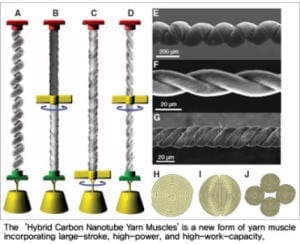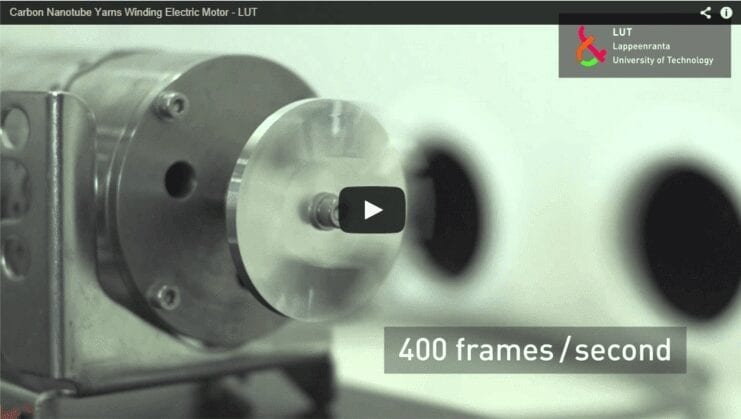
It will have a big impact in the motor, biological and robot industry.
Professor Seon Jeong Kim of Hanyang University has created a high capacity yarn muscle that does not require electrolytes or special packaging. It will have a big impact in the motor, biological and robot industry.
Kim’s article, “Electrically, Chemically, and Photonically Powered Torsional and Tensile Actuation of Hybrid Carbon Nanotube Yarn Muscles,” was published in the journal of Science. He is currently the director of the National Creative Research Initiative Center for Bio-Artificial Muscle at Hanyang University (HYU). In 2006, the research center was designated as the “Leader’s Research Support Business” by the Ministry of Education, Science, and Technology.
Traditional methods of electrochemically powered yarn muscles were destined to include slow responses, low strain and force generation, a short cycle life, and low energy efficiency. They were also in need of electrolytes, counter electrodes, and device packaging. Such requirements increase the weight of the actuator leading to a decrease in performance.
The ‘Hybrid Carbon Nanotube Yarn Muscles’ created by Kim however, has overcome such limitations by confining paraffin waxes, a thermally or electrothermally powered actuators, within the yarn. By doing so, the response rate is enhanced and a helical geometry enables both torsional rotation and tensile contraction.
Muscle contraction — also called actuation — can be ultrafast, occurring in 25-thousandths of a second. Including times for both actuation and reversal of actuation, the researchers demonstrated a contractile power density of 4.2 kW/kg, which is four times the power-to-weight ratio of common internal combustion engines.
Application of the ‘Hybrid Carbon Nanotube Yarn Muscles’ are diverse because the yarn muscles can be twisted together and are able to be woven, sewn, braided and knotted, they might eventually be deployed in a variety of self-powered intelligent materials and textiles.
The Latest Bing News on:
Hybrid Carbon Nanotube Yarn Muscle
- Single-walled carbon nanotubes doped with 'nitrogen' enhance the performance of secondary battery anodeon April 24, 2024 at 9:27 am
Researchers have developed a new manufacturing technique for "silicon/nitrogen-doped carbon composite anode materials." These materials aim to enhance the capacity and stability of lithium-ion battery ...
- Scientists stencil-paint carbon nanotube components for flexible transparent electronicson April 23, 2024 at 9:23 am
Researchers from Skoltech, MIPT, and elsewhere have found a fast and inexpensive way to create geometric patterns in carbon nanotube films. The resulting films turned out to have superior properties ...
- Wearable Batteries Could Soon be Concealed in Strap! Researchers Create Fiber-Like Material That Can Store Energyon April 19, 2024 at 7:59 am
Researchers unveil fiber-like material storing energy, advancing wearable technology with the potential for seamless integration into everyday garments.
- Versatile fibers offer improved energy storage capacity for wearable deviceson April 19, 2024 at 5:57 am
The latest wearable devices, such as Samsung's Galaxy Ring and Apple's Vision Pro, are taking health care a step further and even enabling people to work virtually. Given the characteristics of ...
- Versatile carbon nanotube fibers with dramatically improved energy storage capacityon April 18, 2024 at 5:00 pm
The team reports their findings in Advanced Energy Materials ("Active Material-Free Continuous Carbon Nanotube Fibers with Unprecedented Enhancement of Physicochemical Properties for Fiber-Type ...
- Researchers demonstrate breakthrough recyclability of carbon nanotube sheetson March 18, 2024 at 7:39 am
"These will be able to displace widespread CO 2-intensive materials, such as conventional carbon fibers and some metals like copper, decreasing our future CO 2 emissions footprint." The work ...
- Can we increase the safety of carbon nanotubes?on March 13, 2024 at 7:15 am
This was despite the coverage highlighting concerns with one specific type of carbon nanotube with a long, rigid structure resembling that of asbestos. This type of nanotube, which is no longer ...
- The long and short of carbon nanotube toxicityon January 11, 2024 at 4:53 am
tangled nanotube aggregates or a negative-control carbon-containing compound that is not needle shaped. This suggests increased risk associated with lung exposure to long and rigid CNTs ...
- Textiles and Clothing Newson October 25, 2023 at 5:00 pm
It uses MXene to create a ... Researchers Demo New Type of Carbon Nanotube Yarn That Harvests Mechanical Energy Jan. 26, 2023 — Nanotechnology researchers have made novel carbon nanotube yarns ...
- Carbon Nanotube and Graphene Device Physicson June 17, 2023 at 4:50 pm
Explaining the properties and performance of practical nanotube devices and related applications, this is the first introductory textbook on the subject. All the fundamental concepts are introduced, ...
The Latest Google Headlines on:
Hybrid Carbon Nanotube Yarn Muscle
[google_news title=”” keyword=”Hybrid Carbon Nanotube Yarn Muscle” num_posts=”10″ blurb_length=”0″ show_thumb=”left”]
The Latest Bing News on:
Yarn muscle
- HEALTH AND FITNESS: Recovering from a raceon April 29, 2024 at 4:00 am
Participating in a running race, like the Run United event this past weekend, can be an exhilarating experience. However, it can leave you feeling exhausted and sore. Most commonly associated ...
- What It Takes to Build the Unbeatable Bodyon April 25, 2024 at 12:22 pm
Read a National Geographic magazine article about elite athletes and get information, facts, and more about super performers.
- Mitochondrial DNA copy number contributes to growth diversity in allopolyploid fishon April 22, 2024 at 2:01 pm
Understanding the relationship between mitochondrial DNA (mtDNA) and animal growth could provide valuable information for selective breeding in aquaculture. However, the complex interactions between ...
- International collaboration produces a comprehensive atlas of human skeletal muscle agingon April 22, 2024 at 8:00 am
In a world with rapidly aging societies, there's a need for a detailed understanding of the cause and progression of diseases associated with aging. Skeletal muscle is the key motor system in the ...
- Revolutionary Study Reveals Why Our Muscles Weaken With Ageon April 22, 2024 at 12:32 am
The first detailed cell atlas of aging human muscle uncovers the complex genetic and cellular activities involved in muscle degeneration and identifies ways to mitigate this process. The cellular and ...
- Human muscle aging atlas unveils damage and repair systemson April 18, 2024 at 8:18 am
The first cellular human and mouse map focused on muscle fibers and their microenvironment has revealed both the mechanisms of deterioration of this tissue over time and its adaptive capacity for ...
- Muscle Soreness: What It Is and How To Get Rid Of Iton April 16, 2024 at 10:25 am
When you have DOMS, you’re feeling inflammation from damage to your muscle fibers and the connective tissue (like tendons) that attaches to your muscles. Some people think that DOMS is caused by a ...
- 14 Tips to Maximize Muscle Recoveryon April 15, 2024 at 5:00 pm
When you exercise, the proteins that make up your muscle fibers become damaged. Consuming protein after your workout can help give your body the raw material it needs to repair this muscle damage.
- Fast-twitch vs slow-twitch muscle fibers: What are the different muscle fiber types?on April 15, 2024 at 1:00 am
If you didn’t already know you have different types of muscle fibers in your body, now you do. And depending on how you exercise or what sports you enjoy, you’re building and recruiting some more than ...
- Human muscle map reveals how we try to fight effects of aging at cellular and molecular levelson April 14, 2024 at 5:00 pm
The atlas, published April 15 in Nature Aging, uncovers new cell populations that may explain why some muscle fibers age faster than others. It also identifies compensatory mechanisms the muscles ...
The Latest Google Headlines on:
Yarn muscle
[google_news title=”” keyword=”yarn muscle” num_posts=”10″ blurb_length=”0″ show_thumb=”left”]










